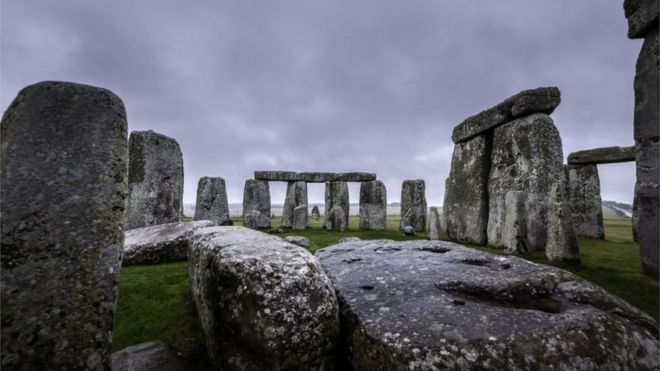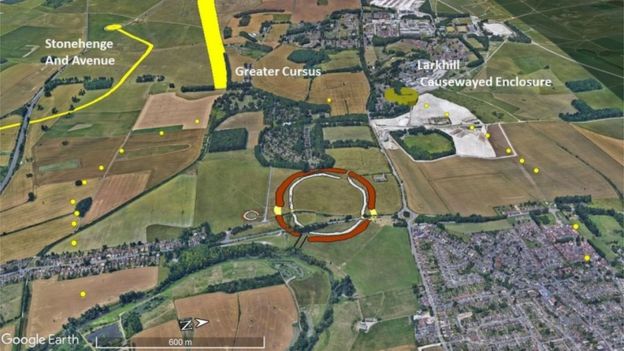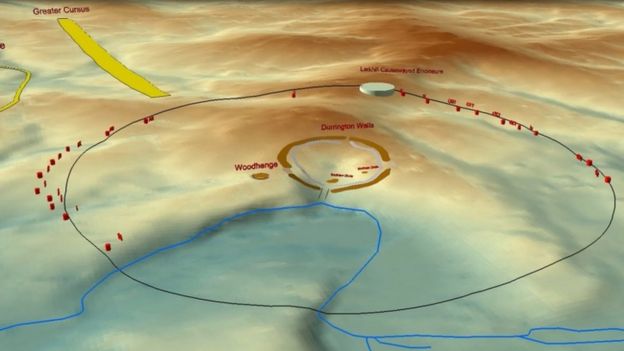Stonehenge - Wikipedia
https://en.wikipedia.org/wiki/Stonehenge
Stonehenge is a prehistoric monument in Wiltshire, England, 2 miles (3 km) west of Amesbury and 8 miles (13 km) north of Salisbury. It consists of a ring of ...Stonehenge: Neolithic monument found near sacred site
 PA WIRE
PA WIRE
A ring of large shafts discovered near Stonehenge form the largest prehistoric monument ever discovered in Britain, archaeologists believe.
Tests carried out on the pits suggest they were excavated by Neolithic people more than 4,500 years ago.
Experts believe the 20 or more shafts may have served as a boundary to a sacred area connected to the henge.
"The size of the shafts and circuit is without precedent in the UK," said Prof Vince Gaffney, a lead researcher.
The 1.2 mile-wide (2km) circle of large shafts measuring more than 10m (30ft) in diameter and 5m (15ft) in depth are significantly larger than any comparable prehistoric monument in Britain.
A team of academics from the universities of St Andrews, Birmingham, Warwick, Bradford, Glasgow and the University of Wales Trinity Saint David worked on the project.
The pits surround the ancient settlement of Durrington Walls, two miles (3km) from Stonehenge, and were discovered using remote sensing technology and sampling.
 UNIVERSITY OF ST ANDREWS/PA WIRE
UNIVERSITY OF ST ANDREWS/PA WIRE
Prof Gaffney, of the University of Bradford, said the discovery demonstrated "the capacity and desire of Neolithic communities to record their cosmological belief systems in ways, and at a scale, that we had never previously anticipated".
"The area around Stonehenge is amongst the most studied archaeological landscapes on earth," he added.
"It is remarkable that the application of new technology can still lead to the discovery of such a massive prehistoric structure.
"When these pits were first noted, it was thought they might be natural features. Only through geophysical surveys, could we join the dots and see there was a pattern on a massive scale."
Prof Gaffney said a "proper excavation" was required to determine the exact nature of the pits but that the team believed they acted as a boundary, perhaps marking out Durrington Walls as a special place, or emphasising the difference between the Durrington and Stonehenge areas.
 UNIVERSITY OF ST ANDREWS/PA WIRE
UNIVERSITY OF ST ANDREWS/PA WIRE
He said it was difficult to speculate how long they would have taken to create, but using manual stone tools, there would have been "considerable organisation of labour to produce pits on this scale".
"The pits are massive by any estimate. As far as we can tell they are nearly vertical sided; that is we can't see any narrowing that might imply some sort of shaft. Some of the silts suggest relatively slow filling of the pits. In other words they were cut and left open," added Prof Gaffney.
Dr Richard Bates, from St Andrews' School of Earth and Environmental Sciences, said it had given an insight to "an even more complex society than we could ever imagine".
His colleague Tim Kinnaird said sediments from the shafts had allowed archaeologists to "write detailed narratives of the Stonehenge landscape for the last 4,000 years".
You may also like:
- Beautiful sunrises and rain as summer solstice celebrated
- Stonehenge summer solstice gathering cancelled
- Family photo from 1875 may be earliest at monument
Dr Nick Snashall, National Trust archaeologist for the Stonehenge World Heritage Site, hailed the discovery as "astonishing".
She said: "As the place where the builders of Stonehenge lived and feasted, Durrington Walls is key to unlocking the story of the wider Stonehenge landscape, and this astonishing discovery offers us new insights into the lives and beliefs of our Neolithic ancestors.
"The Hidden Landscapes team have combined cutting-edge, archaeological fieldwork with good old-fashioned detective work to reveal this extraordinary discovery and write a whole new chapter in the story of the Stonehenge landscape."
考古學家對英國巨石陣的研究越是深入,揭開的謎團就越多,但是,一個完整的故事也在顯現。
http://bbc.in/2exQs0I
http://bbc.in/2exQs0I



沒有留言:
張貼留言